Kristy Athens's Blog, page 5
April 20, 2014
Water Event II
It looks like we survived our first winter in Wallowa County—the valley is green, frogs are getting it on in the swale, and the robins and swallows have returned. The moon and sun’s arc across the sky has shifted significantly since we first got here. Instead of turning the Seven Devils pink when the sun sets, the light hits the Zumwalt Prairie instead. I’m pleased to be unable report on the condition of things at three in the morning, as the puppies are old enough to sleep through the night. Though I miss hearing the great horned owls.
Things were quite manageable until February. The climate here is so dry that the snow hardly accumulates. A push broom was usually more effective than the snow shovel to clear our deck. Shoveling the driveway was unnecessary since there was never more than a Subaru could handle.
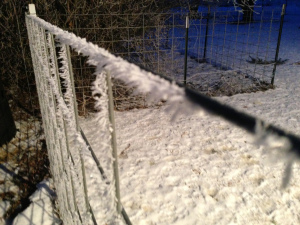
Okay, sometimes it got a little nasty …
But, as I mentioned in a previous post, the snowstorm in the beginning of February was more than we bargained for. Biggest snow in fifteen years, some of the locals say. We shoveled the driveway until we ran out of places to put the snow. Its meltwater inundated our rental’s foundation and created flooding that lasted a week. But once it dried up and the soaked carpet pad was replaced, we thought we were done. Wrong.
About a month later, I was in the basement to collect materials for the workshop I wrote about earlier this month. I pulled out a small suitcase Mike used for Pancake Breakfast merchandise and noticed that the edge that has been against the floor had about six different colors of mold on it. Weird. I pulled out another suitcase, which I bought at a yard sale in fourth grade for my doll clothes and, more recently, have used in my ithaka display at Wordstock. Its little brass feet had left four rust circles in the carpet. Oh, crap. While there was flooding along the east wall that we noticed, the north wall had quietly been seeping as well.
Behind the suitcases was a cardboard apple box in which I stored all my reference materials for Get Your Pitchfork On!—horse magazines, county welcome guides, other moving-to-the-country books, and all my notes from screeners of the original draft. Everything up about three inches from the bottom of the box was ruined.
The paperboard backs to my new shelves were warped; thankfully the shelves themselves are metal. Then I looked to my left and winced. Mike’s banjo was in its soft case, leaned up against the wall. I pulled it out and it, too, had taken on a bunch of different kinds of mold. It absorbed so much water that the strings rusted and broke. The case for the bass guitar (which thankfully, was elsewhere) was also moldy.

Sad banjo
Since this was water from outside (as opposed to faulty plumbing), our insurance company wouldn’t touch it. We considered asking the owner of our house to reimburse us but realized he was in the same boat. No one on a hill buys flood insurance! And he had a bunch of repairs to pay for.
As I mention in GYPO, it’s hard to find handypersons for small jobs; they all want to work on the big jobs with steady pay. The owner got someone to pull back the carpet, cut about eight inches of drywall away from the floor and put a fan on it. But he couldn’t get anyone to come back to clean the mold or replace the drywall! After a couple weeks of not being able to use the basement nor access the things that are packed, Mike has graciously offered to fill in. I know I said this last time, but now I’m really hoping we can put Water Event 2014 behind us.


April 13, 2014
Diane Sward Rapaport’s Home Sweet Jerome
One of the Classic American Stories is that of “cool” people—artists, anti-establishment politicos, and other bohemians—finding ignored or abandoned places and revitalizing them, until they become so popular that the cool people can no longer afford and/or abide them.
Jerome, Arizona, is one of those places. I’ve never been there but, during my two-month residency in Harney County in 2010, I became friends with two refugees, Diane and Walt. They had moved to Jerome in the 1980s as refugees of another fantastic-turned-overwrought scene, 1960-70s San Francisco, where both were in the music business.
Diane was a generous host when I knew only a handful of people in Harney County, and we stayed in touch. She provided comments on parts of Get Your Pitchfork On! and I consulted on a few bits of her new book, Home Sweet Jerome, about the mining town-turned-hippie town-turned tourist destination that she and Walt still hold very dear. Diane donated a piece about grasshoppers to the GYPO blog, which continues to be one of my most popular internet-searched posts! Even if you don’t have a personal connection with the town itself, Diane’s story captures a generation perched between the Old West and the Modern Age, with lots of pot-smoking and under-the-cover-of-night shenanigans. Check it out!

Diane Sward Rapaport;
photo by ML Lincoln


April 6, 2014
Devil’s Gulch Plein Air Adventure
On Friday I got to blend a whole bunch of my favorite things: Making collage art, hiking, writing, checking out a new place, and hanging out with kids! Fishtrap, one of Oregon’s literary organizations, and Wallowa Resources, a natural-resource-management nonprofit, invited me to lead a day-long workshop with their WREN program, a sort of day camp for kids to make up for the school districts not convening on Fridays.
The plan was to hike into the canyonlands and do some plein-air writing. Some of you may recall that I was a writer-in-residence in Harney County in 2010, during which time I worked with children and adults to explore the craft of writing in the out-of-doors using all of one’s senses. (This residency also allowed me to write the bulk of Get Your Pitchfork On!.) I dusted off my old plein air workshop notes, found sewing instructions from a book-making workshop I took at Pacific Northwest College of Art and Design, and packed up a box of books and magazines to sacrifice to the greater good. Program coordinator Amy Busch gathered awls, needles and other materials.
But before we could write, we needed notebooks. I showed them how to create collage designs on sheets of cover stock and then sew blank paper into the spine.
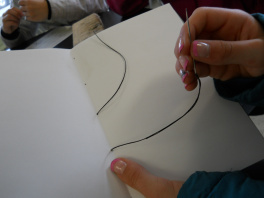
One of the students sewing her book
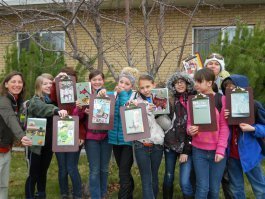
Good-looking notebooks!
It was a good thing Amy procured waterproof paper for our notebooks. It drizzled on our hike up Devil’s Gulch, and as soon as everyone found a private, quiet spot to write, the rain picked up. Even so, the kids were quiet for a good twenty minutes. Then, we crowded into an old herder’s cabin, keeping a distance from the pack rat nest that occupied most of the bunk, and shared our work. One girl read a particularly astute description of the canyon, including past and present, and noting how life and death coexist there.
One of my favorite parts about working with teenagers (or, these days, pretty much any child older than ten) is that they never let on that they’re enjoying what you’re doing while you’re doing it. But then they surprise you at the end with their work.
I recently received a fellowship for my plein air writing, and will read some work—including my new Wallowa County piece—as a featured writer at Fishtrap’s Fireside program on Friday, April 11.
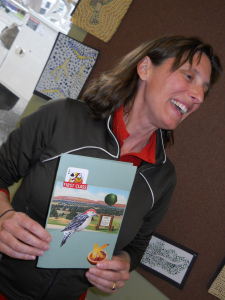
Photos courtesy of Fishtrap


March 30, 2014
Ode to a Subaru: 288,923 Miles and Counting
Our Forester Subaru is on hospice. At nearly 300,000 miles, it has bearings in the transmission and the rear differential that are too expensive to fix.
I am not sentimental about cars. I named only one car, in high school (Fifi the Fiesta), and I loved only one car, an Isuzu Trooper that I bought in 1993 with my own money. I put a bumper sticker on the back that read: “This is what a radical feminist looks like.” I sanded and repainted the rusting bumpers myself. I learned how to replace the oil and change a tire. I drove the Trooper around proudly, like it was an extension of myself.
A year later, a driver blew through a red light in front of me. The Trooper was totaled. I was unhurt but devastated.
After that, cars became tools. Sentimentality for a car is doomed.
In 2001, Mike and I were in the market for a new vehicle. Not new-new, of course—who buys a car new? They lose half their value when you drive off the lot; everyone knows that. But something a little bigger than our Volkswagen Cabriolet and not quite as janky as our Toyota LE van (which had been broken into and/or stolen so many times that you had to start it with a screwdriver). Five-grand-ish.
Lacking enough savings, we went to our credit union only to find that financial institutions had essentially stopped lending money for used cars. We could have put a car on our credit card, but the interest would be ridiculous. Our best option was … a car dealer. We found a salesman who was experimenting with an “Internet special.”
The Subaru Forester we ended up with was absolutely luxurious compared with what we were used to. Six-CD changer! Power sunroof! Power locks! Power windows! (We actually asked for crank windows; which we couldn’t get if we wanted the sunroof, which we very much did.) You could drive on the highway and have a conversation, rather than listen to the roar of the leaky window seals.
My dad was leery; he and my mom bought a four-wheel-drive Subaru wagon in 1978 that was a “total lemon” (this is a cleaned-up version of my dad’s description of the car). I grew up believing Subarus sucked, but my high school friends who had ventured west after graduation, to rustic places like Colorado and Alaska, all swore by them. By 2001 Mike and I had been in Oregon for six years, long enough to have ridden in dozens of friends’ Subarus, and realized it was the right car to balance road trips with gravel logging roads.
When we moved to the Columbia River Gorge in 2003, our neighbors asked, “Do you have a four-wheel-drive?” When we moved up Alder Slope last fall, our neighbors asked, “Do you have a four-wheel-drive?” Yes, we do.
Since 2001, this Forester has been in every Oregon county except Lake; back and forth to Minnesota; down to San Francisco; up to Seattle. It busted us out of our snowy driveway in the Columbia River Gorge a hundred times. One of its first road trips was to Hat Point in Wallowa County, 21 miles from the remote town of Imnaha, on a one-lane dirt Forest Road with 1,000-foot drop-offs. It has never broken down on us once.
Now, I used to do community outreach for a hospice, so I can’t pass up this teachable moment to clear up a common misperception: Hospice is about quality of life, not crisis management. Being on hospice means there is something wrong that can’t be fixed; it doesn’t (or shouldn’t) mean imminent death. If it’s done right, comfort care can make the last few months of life comfortable, less stressful, and even enjoyable.
Okay, back to the program. So the Forester probably won’t last the rest of the year. It’s fitting for its life to end in Wallowa County. We’re still gunning for 300K. The engine has some leaky gaskets but otherwise is fine. We’ll keep putting oil in. Living up a rocky dirt road certainly isn’t doing the bearings any good. We’ll see. Whenever the time comes, I will have nothing but respect for this tool that has served us well.
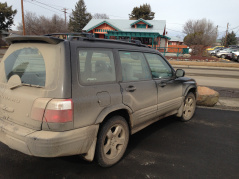
Living up a dirt road=perpetually dirty car!
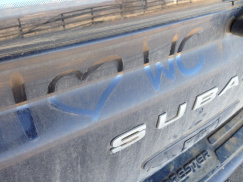
I Wallowa County


March 23, 2014
Springtime Strawberry Pot
I finished my finals for winter term! To treat myself for this incredible feat, I went to the local plant nursery. I know it’s too early to think about planting anything, plus we don’t have garden beds, and building some would be a huge job, as we’d have to put in 8-foot fence to keep the deer out of it. I just went there to walk amongst plants and smell the foliage and dirt.
But something was waiting for me! A bright blue strawberry pot. When I was a kid, I used to hang out with adults all the time (they were much more interesting than children and they didn’t make fun of my glasses, hair or anything else). One of my neighbors in Springfield, Illinois, where I lived in kindergarten, had a strawberry pot. I was fascinated by it–all the little nooks for the daughter plants, and strawberries themselves, growing on a plant! I’ve always wanted one.
This nursery is just getting started for spring, so there’s not a lot there yet. But there were little strawberry starts! My winter-term treat materialized.


March 16, 2014
The Future of Female Farming Entrepreneurship?
Note: I am smack-dab in the middle of writing my final papers for the winter term of my graduate Food Systems & Society program at Marylhurst University, so I am, once again, taking advantage of work I produced last term to serve as my blog post. Plus, I added a new venue: The Lostine Tavern, which is in the middle of a crowdfunding campaign to re-open its doors this May! I am very much looking forward to it!
Chapter 6 of Together at the Table and the piece “Five Faces of Oppression” make me especially interested in the small-farm and local food phenomenon occurring in the county in which I live, Wallowa County, Oregon. Because of the area’s relative monoculture and relative poverty, the study of privilege takes an interesting tack.
In “Five Faces of Oppression,” Young notes that “… for every oppressed group there is a group that is privileged in relation to that group.” I find this distinction important: One group is not necessarily consciously lording over another group in order for the latter group to lack the same opportunities and rights. This is certainly the case in Wallowa County, where men operate most of the businesses, especially the county’s lead industries.
Wallowa County’s main industry remains forestry. The county’s main agricultural industry (45 percent) is beef cattle ranching. There is also farming, most of which is three kinds of hay for wintertime feeding of cattle (34 percent) and wheat for export (11 percent).
Leadership and activism being born in privilege (Allen, p. 161) may be easier to demonstrate in wider society, because there is more diversity in race, ethnic background, religion, social class, etc. Wallowa County is a bit of a monoculture. European Americans have dominated the county since the late 1800s, after they forced the native Nez Perce from the Wallowa and Imnaha valleys (“Chief Joseph,” n.d.). In the 2010 national census, 4.0 percent of the population identified as “minority,” and 2.2 percent identified as Hispanic (Northeast Oregon Economic Development District, p. 31).
Wallowa County has a 46.3-percent rate of self-employment (the Oregon average is 22.6 percent); however, the average income is $12,170 (Northeast Oregon Economic Development District, p. 15). Against this backdrop, a number of small farm enterprises have been launched in the past five years, all but one run by women:
Magic Garden: Farm-to-school project planted on land that was donated by a local ranching family (locations in Joseph and Imnaha)
Slow Food Wallowas: Chapter of Slow Food USA based in Enterprise
Backyard Gardens: Farmers market stand and CSA with delivery locations in Enterprise and Joseph
M Crow: A reclaimed general store that sells local produce and meat, and handmade items, as well as hardware, clothing, supplies, and other wares, in Lostine (the exception; founded by a man)
June’s Local Market: Produce and locally made value-added products such as canned jams and salsas, jewelry, and gifts, in Lostine
Wallowa County Farmers Market: Locations in Enterprise and Joseph, SNAP/WIC/FDNP accepted
Lostine Tavern (opening May 2014), being billed as a farm-to-table restaurant, co-owned by a woman and a man
 Additionally, most of the non-commodity farming in the region is led by women. Of the eleven listings for farm/ranch operations in Oregon Rural Action’s Food and Farm Directory, seven have female sole proprietors, including 6 Ranch, a cattle and sheep ranch run by a mother-daughter team (Oregon Rural Action, p. 10-11).
Additionally, most of the non-commodity farming in the region is led by women. Of the eleven listings for farm/ranch operations in Oregon Rural Action’s Food and Farm Directory, seven have female sole proprietors, including 6 Ranch, a cattle and sheep ranch run by a mother-daughter team (Oregon Rural Action, p. 10-11).
While men still run the most lucrative businesses in Wallowa County, this influx of female food-industry entrepreneurs proves to be an interesting microcosm of a potential sea change within agriculture.
Resources:
Chief Joseph. (n.d.). Retrieved Nov. 11, 2013, from http://en.wikipedia.org/wiki/Chief_Joseph
Oregon Rural Action. (2012). Food and Farm Directory. La Grande, OR: Author.
Northeast Oregon Economic Development District. (2013). Comprehensive Economic Development Strategy. Enterprise, OR: Author.
Wallowa County Farmers Market. (n.d.). Retrieved Nov. 11, 2013, from http://www.wallowacountyfarmersmarket.com/


March 9, 2014
Women’s Month Art Show
Yesterday, March 8, was International Women’s Day. That’s right, ladies, we get a WHOLE DAY! Par-ty!
Snark aside, International Women’s Day and the United States’ National Women’s History Month are important touchstones for considering the progress that has been made in the realm of women’s rights throughout the world. So long as we have public stonings, female circumcision, domestic violence, sexual assault, and education and income discrepancies, we continue to need to shine the spotlight on women and girls.
At one of my favorite places in Wallowa County, the Josephy Center for Arts and Culture, executive director Cheryl North Coughlan lined up an extraordinary range of programming to commemorate Women’s History Month, from brown-bag lunches that consider the role of women in ranching and farming and Title IX, to presentations by Eastern Oregon University’s Lidia Yuknavitch and Rebecca Hartman, to a showing of the Oregon Public Broadcasting documentary about Gwen Trice, The Logger’s Daughter.
The discussion of women’s roles in agriculture was, as you can imagine, extremely interesting for me. Wallowa County has what I think is an extraordinary number of women-run operations, and so I’m interested in learning more about that. The panel consisted of fourth-generation Oregonian rancher Jill McClaran, fellow ex-suburbanite and now CSA farmer Beth Gibans, and Wallowa-County-native-turned-East-Coast-urbanite-turned-Wallowa-County-native goat rancher Wendy McCullough, but there were plenty of other farmers and ranchers in the audience. The program was more of a conversation than a presentation. The older women expressed their envy of the young ones; in their day, women did just as much work as their brothers and husbands but, because of their gender, got no credit for their efforts nor had any legal or decision-making authority.
And, since the main floor of the Josephy Center is a beautiful gallery, there is also an exhibit (“Women’s Art, Women’s Vision”) that features local artists, including me! I was honored to receive an invitation to include some of my collage pieces. If you are in the area, be sure to check them out!

Detail of “Tradition”
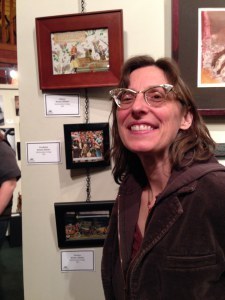
At the Josephy Center opening night


March 2, 2014
Spring’s Reclaimed Toys
Our puppies have loved and abandoned a number of toys. I get them at the local thrift shop, so they’re easy to replace. Some are destroyed to the point that I have to throw them away. Some have been left in the yard, and then snowed over, and then forgotten. As the snow has thawed, they’ve reappeared. They’re looking a little worse for the wear.
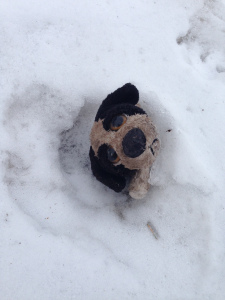
This lil’ guy was once just a little bit smaller than the puppies
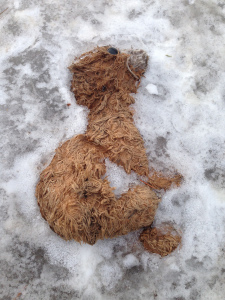
Sad kitty cat

Spring flowers in bloom!

Tug-of-war with the snow
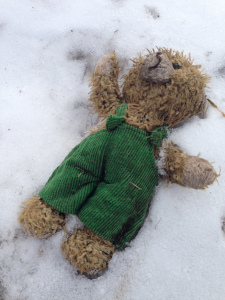
Sad teddy bear in adorable overalls
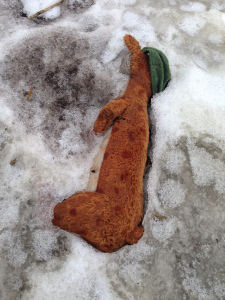
Some sort of Disney character? A ferret with an eyepatch
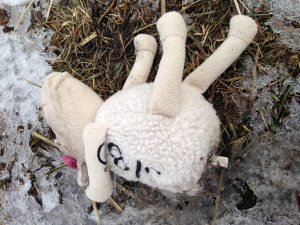
Sad Sealy Posturpedic promotional sheep. 3/8, if I remember correctly


February 23, 2014
Can Tiny Gardens Feed the World?
Note: This is the second time I’m taking advantage of my status as a student in Marylhurst University’s Food Systems and Society master’s program to use
some of my writing from last quarter.
I am fascinated by the obsession some of my cohort members have with local community gardens. It seems that many of them actually feel that community gardens might save the world. Have they not seen community gardens? Do they not recognize the theft that occurs? Do they not realize their seasonal limitations? Their limitations of scale?
Community gardens are wonderful things; don’t get me wrong. They provide a place for people who live in “un-landed” domiciles (i.e. apartments or homes on small lots) to be able to experience the joy of working a plot of earth and raising a bit of food. And they create mini-communities of gardeners.
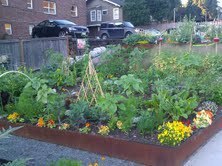
Beautiful plot grown by my friend Rebecca
But by “a bit of food,” I mean a bit. My friend Rebecca has a plot in the P-Patch in Seattle’s Belltown neighborhood (which has appeared in this blog before). We went to see it when I was visiting. I noted the 3-foot-by-6-foot raised bed and thought, “Oh dear, what a tiny area to work with.” And then I realized she only had half of it.
Granted, at the time I was coming from managing a garden that was 100 feet across. But even that was not enough. There is no way I could have grown enough food to sustain my family of two off of that plot. It was something I did for pleasure. And it’s a good thing I enjoy gardening, for it basically commandeered my every weekend from May to September, and certainly didn’t save me any money if I factored in my time.
I don’t think people understand what is involved in growing food. Community gardens are more of a community-building activity than an arrow in the quiver of food security. Additionally, they are usually places of privilege—the P-Patch of which my friend Rebecca is a member has a waiting list, which means anyone who would like to garden there must have a fairly stable life, phone number, address, etc. As Allen notes, “[Community] is defined differently by different people as mediated by income, wealth, property ownership, occupation, gender, ethnicity, age, and many other personal characteristics” (Allen, 2004, p. 179).
So, how can we feed everyone without destroying the environment with toxic chemicals and excessive petroleum-based fertilizers, and exploiting thousands of farm workers? I propose a tiered system of personal (backyard chickens, tomatoes in buckets), local (CSAs and small farms supporting local markets), regional (grow food where it grows best in a sustainable manner), and global (disaster relief, staples, global trade of responsibly grown specialty items) food-growing efforts.
Feeding the world can be done; but it will take more than a few beautiful backyard garden plots.
Reference:
Allen, P. (2004). Together at the table: Sustainability and sustenance in the American agrifood system. University Park, PA: The Pennsylvania State University Press.


February 16, 2014
Water Event
Mike’s birthday was two weeks ago; we celebrated in front of a roaring blaze in the backyard fire pit. As we wrapped it up around 10 (it was a school night and, moreover, we are old), little flakes of snow started to drift down. We basked in the glow of the bonfire and enjoyed the lovely scene.
The next morning, it was still snowing. In fact, it snowed almost nonstop that week, and by last Saturday the fire pit, and the previous icy crust surrounding it, were covered with a foot of new snow. It took nearly all day to clear our 100-foot-long driveway. Snow here falls pretty dry and light, but the longer you wait, the harder it will be to remove it. We got on task fairly early, which saved us from having heart attacks. (I had been told in September by the county plow dude that it was unusual to get more than a couple inches at a time, so we’d limited our snow-removal equipment purchases to a single shovel.)
Monday, I skied the field with the dogs. Tuesday, it was too soft. Wednesday, the new snow had collapsed and was melting into torrents of cold water. Since we live on a slope, everything above us ran toward the house.
Water takes the easiest route available to it. When it got to our house, some of it went around and some of it went through. Through the foundation, that is, and then pooled in the furnace and laundry rooms.

This should be our backyard, not a lake
This is called a “water event.” Where we live now and where we lived in the Columbia River Gorge are, mostly, different. There was forested and here is cleared. There has Douglas fir and here has tamarack. There has Cascades running north and south, and here has Wallowas running east and west. One thing the properties have in common is slope, and slope means when there’s water, there’s running water.
In Get Your Pitchfork On!, I write about the struggles we had in the Gorge to keep our swales from eroding into deep chasms and collapsing banks. But we’d never had water in the house.
Thursday morning we took turns with the shop vac, hauling 35 gallons of water out of the basement in five-gallon increments. The trouble was, where to put it. Lugging a sloshing pail of meltwater out the basement door, I realized the carport was also flooded.
[image error]
Putting the “port” in carport …
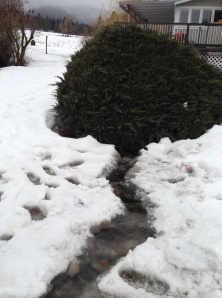
Trenching
Mike initiated a trenching campaign, digging channels in the snow to coax the water across our backyard and around the house, and then draining the carport into the field below it. I made one trench myself: It was fascinating to spade a path through the snow and watch the water take it over. It reminded me of childhood engineering projects in the woods near my house.
I generally love the sound of a babbling brook, but not so much when it is running under my porch. As with the snow, it was in our best interest to address the water right away. The trenching saved us gallons of vacuumed water in the basement.
Now, the worst seems to be past us. The carpet in the basement will need to be cleaned, and then we will put Water Event 2014 behind us.







